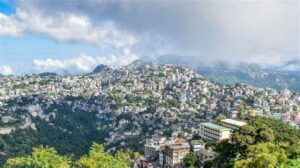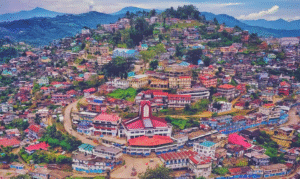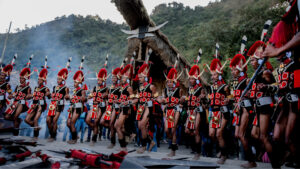Introduction
The Hornbill Festival, celebrated every year from 1st to 10th December in Kisama Heritage Village, Nagaland, is famously referred to as the “Festival of Festivals“. Rooted deeply in the vibrant traditions of the Naga people, this grand event is not just a cultural exhibition but a dynamic convergence of indigenous heritage, identity, and modern expression. Named after the hornbill bird, revered in Naga folklore, the festival has grown into one of the largest and most colourful celebrations in Northeast India, drawing visitors from around the world. It offers an immersive experience of the 16 officially recognized Naga tribes, each bringing unique customs, attires, cuisine, rituals, and dances to the shared platform of Kisama.
Historical Background
The Hornbill Festival was launched in 2000 by the Government of Nagaland, aimed at fostering inter-tribal interaction, preserving fading traditions, and promoting Nagaland tourism. The site chosen—Kisama Heritage Village, about 12 km from Kohima—is strategically located to serve as a central venue where all tribes can come together. The festival was conceptualized not only as a cultural celebration but also as a socio-political effort to reinforce unity among Naga communities and display their distinct identity in the Indian cultural mosaic.
The name “Hornbill” itself is symbolic. The great Indian hornbill is known for its grandeur and presence in many Naga tribal tales, particularly among the Ao, Angami, and Sumi tribes. It represents valor, cultural continuity, and environmental harmony—values central to Naga identity.
The Venue: Kisama Heritage Village
Kisama, a portmanteau of two neighboring Angami villages, Kigwema and Phesama, was developed as a permanent venue to house the Hornbill Festival. The village is an architectural embodiment of Naga life, with traditional morungs (bachelor dormitories), log drums, and thatched tribal huts representing all 16 tribes.
Each tribal hut or morung showcases distinctive wood carvings, symbols, traditional weaponry, agricultural tools, and handicrafts. Visitors are encouraged to step inside, interact with tribal members, taste ethnic cuisine, and witness daily life as it would unfold in an actual Naga household. This immersive ethnographic experience turns Kisama into a living museum of Naga culture.
Major Attractions and Cultural Significance
1. Tribal Dances and Music
One of the festival’s central attractions is the daily tribal dance performances, featuring war dances, harvest dances, and courting rituals, all performed in full traditional attire. The beats of log drums, bamboo flutes, and chants create an earthy rhythm that resonates across the venue. The dances are not merely performances but dramatized storytelling—conveying themes of bravery, gratitude, fertility, and communal bonding.
Traditional music groups also showcase ancient folk instruments like the mouth organ, bamboo trumpets, and gongs. Each tribe performs songs in their native tongue, with lyrics often referencing ancestral myths, nature, and collective memory.
2. Traditional Sports and Games
The Hornbill Festival hosts a range of indigenous sports, many of which trace their origins to Naga martial traditions. Events like Naga wrestling (Kene), archery, and log cutting offer insights into the physical prowess and competitive spirit embedded in tribal life. Wrestling, particularly among the Angami and Chakhesang tribes, is both a sport and a rite of passage, with strict rules and ceremonial value.
3. Handicrafts and Indigenous Art
The handicraft section at the festival is a vibrant marketplace displaying bamboo products, wood carvings, cane baskets, jewelry, textiles, and beadwork. Each item is a manifestation of intricate knowledge systems passed down through generations. The rich Lotha beadwork, Ao shawls, and Zeliang carved wooden panels are more than decorative objects—they are cultural texts embedded with tribal identity and symbolism.
Live demonstrations of weaving, basket making, and wood carving allow visitors to observe the intergenerational transmission of artisanal knowledge, critical to understanding how tradition is sustained in Naga society.
4. Naga Cuisine and Rice Beer
No cultural festival is complete without food, and Hornbill offers a sensory exploration into Naga culinary traditions. Stalls feature dishes like smoked pork with bamboo shoots, axone (fermented soybean), dry river snails, and sticky rice. Spices such as the infamous Bhut Jolokia (ghost pepper), one of the world’s hottest chilies, feature prominently in many recipes.
Equally significant is the traditional rice beer, called by different names in various dialects (e.g., Zutho by the Angami, Thutse by the Chakhesang, and Apong by other tribes). More than a drink, rice beer is used in rituals, community feasts, and as a symbol of hospitality.
Integration of Modern Events
While rooted in tradition, the Hornbill Festival has also embraced contemporary forms of expression. Events like:
- The Hornbill International Rock Contest
- Fashion Shows highlighting Naga textiles
- Film screenings and photography exhibitions
- Literary festivals and indigenous storytelling sessions
These platforms create opportunities for young Naga artists, designers, musicians, and writers to reinterpret their heritage in modern formats. The inclusion of motor rallies, cycling events, and cosplay competitions represents a fusion of local culture with global youth trends, helping sustain relevance among the younger demographic.
Unity in Diversity: A Pan-Naga Expression
Nagaland is home to more than 35 recognized ethnic groups, many of which have historically had inter-tribal conflicts. The Hornbill Festival serves as a rare platform of collective unity where all tribes present their cultural identities in harmony. Each day is assigned to different tribes, allowing them to showcase unique rituals without hierarchy.
The Nagaland State Government’s Department of Art and Culture, in collaboration with tribal councils, ensures equal representation, demonstrating how the festival is as much about community cohesion and peacebuilding as it is about celebration.
Educational and Heritage Preservation Aspects
Beyond tourism and performance, the Hornbill Festival plays a significant educational role. The presence of tribal elders, folk historians, and craftspeople enables the transmission of oral history and ancestral knowledge to both the younger Naga generations and outside observers.
Workshops and exhibitions often focus on:
- Endangered dialects and scripts
- Indigenous agricultural methods
- Shamanic healing traditions
- Storytelling as pedagogy
This educational component positions the Hornbill Festival as a cultural conservation tool, addressing challenges of globalization, urban migration, and loss of intangible heritage.
Tourism, Economy, and Sustainability
The economic impact of the Hornbill Festival is notable. It has significantly boosted eco-tourism, local crafts sales, and hospitality sectors in and around Kohima. Homestays in nearby villages, local transportation services, and handicraft cooperatives see an annual spike in activity.
However, the influx of tourists also raises concerns about cultural commodification, over-commercialization, and environmental degradation. Recent editions of the festival have introduced green initiatives, such as waste segregation, discouraging plastic use, and encouraging sustainable tourism models. The involvement of local youth organizations and NGOs ensures that the development remains community-led and environmentally sensitive.
Global and Pan-Indian Cultural Exchange
With increasing international participation, the Hornbill Festival has become a gateway for cross-cultural interaction. Artists and visitors from countries such as Thailand, South Korea, Germany, and the United States have performed and engaged in cultural exchange programs. Similarly, cultural troupes from other Indian states like Rajasthan, Punjab, and Assam are often invited, enriching the diversity of the festival.
This makes Hornbill a space not just of tribal pride but of intercultural dialogue, embodying both local rootedness and global openness.
Challenges and the Road Ahead
Despite its popularity, the Hornbill Festival faces several challenges:
- Balancing authenticity with performance: There’s a fine line between showcasing culture and staging it purely for entertainment.
- Political complexities: As a state with a unique political history, maintaining the festival’s apolitical nature is essential.
- Infrastructure pressure: Growing crowds strain transport, accommodation, and waste management systems.
To address these, the state has initiated plans to decentralize festival events, encourage community-managed tourism, and improve rural connectivity. Ensuring that the festival remains rooted in community agency, and not overrun by external interests, is vital for its continued success.
Conclusion
The Hornbill Festival at Kisama Village is more than just a spectacle—it is a profound celebration of identity, continuity, and cultural pride. It serves as a living classroom where ancient traditions and modern expressions coexist, educating attendees while empowering the Naga community to define and narrate their own story. By upholding tribal knowledge, promoting unity, and adapting to contemporary formats, the festival exemplifies how culture can remain vibrant and relevant in an ever-globalizing world.






